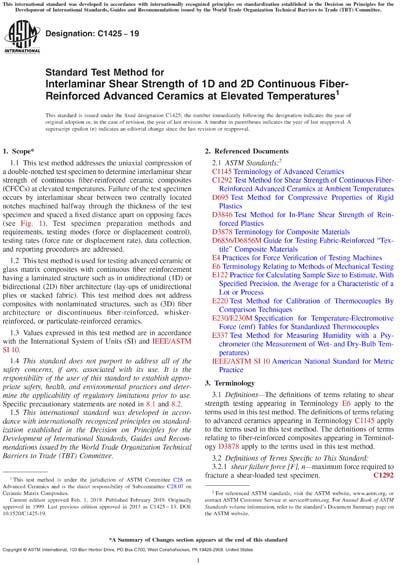Most recent
ASTM C1425-19
Standard Test Method for Interlaminar Shear Strength of 1D and 2D Continuous Fiber-Reinforced Advanced Ceramics at Elevated Temperatures
1.1 This test method addresses the uniaxial compression of a double-notched test specimen to determine interlaminar shear strength of continuous fiber-reinforced ceramic composites (CFCCs) at elevated temperatures. Failure of the test specimen occurs by interlaminar shear between two centrally located notches machined halfway through the thickness of the test specimen and spaced a fixed distance apart on opposing faces (see Fig. 1). Test specimen preparation methods and requirements, testing modes (force or displacement control), testing rates (force rate or displacement rate), data collection, and reporting procedures are addressed.
FIG. 1 Schematic of Uniaxial Compression of Double-Notched Test Specimen for the Determination of Interlaminar Shear Strength of CFCCs


1.2 This test method is used for testing advanced ceramic or glass matrix composites with continuous fiber reinforcement having a laminated structure such as in unidirectional (1D) or bidirectional (2D) fiber architecture (lay-ups of unidirectional plies or stacked fabric). This test method does not address composites with nonlaminated structures, such as (3D) fiber architecture or discontinuous fiber-reinforced, whisker-reinforced, or particulate-reinforced ceramics.
1.3 Values expressed in this test method are in accordance with the International System of Units (SI) and IEEE/ASTM SI 10.
1.4 This standard does not purport to address all of the safety concerns, if any, associated with its use. It is the responsibility of the user of this standard to establish appropriate safety, health, and environmental practices and determine the applicability of regulatory limitations prior to use. Specific precautionary statements are noted in 8.1 and 8.2.
1.5 This international standard was developed in accordance with internationally recognized principles on standardization established in the Decision on Principles for the Development of International Standards, Guides and Recommendations issued by the World Trade Organization Technical Barriers to Trade (TBT) Committee.
Content Provider
ASTM International [astm]






